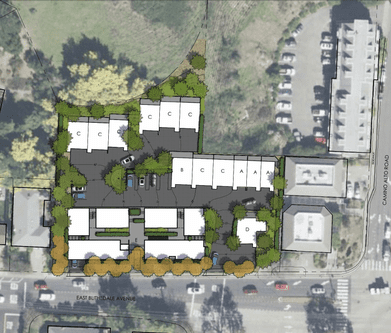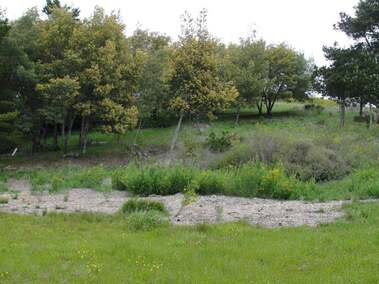Each time Richardson has gone to City Hall for a public hearing or informal study session since he bought the 1.2-acre property in 2004, Richardson’s faced stiff opposition from neighbor groups that have packed public hearings, hired land-use attorneys and gone back and forth with him via sign wars.
 An aerial rendering of the proposed project for 575 East Blithedale.
An aerial rendering of the proposed project for 575 East Blithedale.
Richardson, who moved to Mill Valley in 1967 and has lived in Tiburon for the past several decades, is in the midst of preparing his latest application to the City of Mill Valley, this time for a project he says reflects his longtime membership in the non-governmental Mill Valley Affordable Housing Committee and the Rotary Club of Mill Valley, as well as a heightened desire within the community for a project that creates some more affordable housing opportunities, particularly for first responders, teachers and essential workers.
Richardson’s latest proposal, now called Richardson Terrace in place of the Blithedale Terrace moniker of yore, calls for 25 homes – six market-rate homes for seniors, six homes for lower-income residents, 13 market-rate homes and 2,000 square feet of office space. The development would include 52 underground parking spaces, Richardson said.
Richardson says that his latest proposal responds directly to the concerns of City planning commissioners in 2017 by reducing the height along the street from three stories to two, by putting the parking underneath the project, by having only one single-family home on the street and by increasing, with both the six units for seniors and six affordable units, the mix of units.
Richardson says he hopes that the City of Mill Valley, drawing at least in part on the Affordable Housing Trust funds raised via the city’s 1 percent City fee applied to all new housing projects and remodels costing $100,000 or more, to buy some of all of the affordable units and make them available for rent to city employees, much like the Town of Tiburon did with six units within its Point Marsh complex.
“This project is not detrimental in any way that I can see,” says Richardson, who hired renowned architect Mark Cavagnero to design the latest proposal in an effort to address the Planning Commission’s expressed desire in 2017 for more modernity in the buildings. “It provides 12 units for people that need access to local housing, nothing’s bigger than 2,000 square feet
He says he hopes to get a hearing for later this year. In doing so, he seeks to end a journey that’s well into its second decade.
 The vacant lot at 575 East Blithedale Ave.
The vacant lot at 575 East Blithedale Ave.
The city released the draft EIR in March 2010, analyzing the project’s impact with regards to aesthetics, air quality, biological resources, geology and soils, hydrology and water quality, noise, transportation and traffic, hazards and hazardous materials, land use, population and housing and public services. The final EIR was posted in 2012.
At a 2012 study session, Richardson’s project called for a terraced plan of 20 single-family, two- and three-bedroom townhomes varying in style from 1,100 to 2,000 square feet. Of the 20 units, two would be reserved for lower-income households and two for moderate-income households. In an attempt to get a sense of what, if any, variation on his proposal the community could support, Richardson also put forth a project that included alternatives eight units and four second units.
The Blithedale Terrace property was included in the city’s 2003 Housing Element update as a place for a 20-unit residential development as part of the city’s efforts to meet from the Association of Bay Area Governments (ABAG). Richardson’s property was included in the Capacity Analysis within the City’s 2015-2023 Housing Element.
In an op-ed in 2012, Richardson wrote, “it appears that the community needs to do some soul searching. Is this a town where only the wealthy can move in by building large houses on steep lots in our canyons? Why can’t the ordinary citizen have an opportunity to live in a 21st Century home in Mill Valley, one that is within walking distance to everything?”
In 2017, at an informal study session with the Planning Commission, Richardson received similar objections to his proposal of 20 two- and three-bedroom, three-story townhouses, ranging from 1,200 to 2,100 square feet Commissioners told Richardson at that time that they preferred smaller-scale projects that include affordable housing, or senior housing with fewer units and bedrooms, and also included a mix of uses, such as office spaces, given its mixed use zoning designation.
‘Affordable’ Housing
Better than most, Bruce Dorfman understands the complexities of building anything, particularly anything affordable, in Mill Valley. His firm Thompson Dorfman tried to build a small project in its parking lot Forrest St. in 2007, a project that sought to work with the Mill Valley School District and provide four residential townhouses designated for teachers. Like Richardson’s past efforts, that project also received considerable opposition from neighbors and other groups concerned about density, re-zoning requirements and the removal of a tree.
“The only way to get true (deeded) inclusionary or affordable housing built is that you have to build a project large enough to make this requirement a necessity for approval as well as economically sustainable,” Dorfman said.
Given Mill Valley’s lack of large, vacant lots, local officials and developers will likely have to continue to “hit singles,” as Councilmember Urban Carmel explained last week about the city’s focus on promoting the creation of accessory dwelling units (ADUs) and its new “House Mill Valley” house match program via Covia.
“In Mill Valley’s case, given the lack of large-scale projects, we’re going to need to create affordable housing on a onesie twosie basis,” Dorfman says. “But if we do it enough, it’s a good and necessary start.”
Here’s a slideshow of the renderings of the 575 East Blithedale Ave. project:
Want to know what’s happening around town? Click here to subscribe to the Enjoy Mill Valley Blog by Email!


